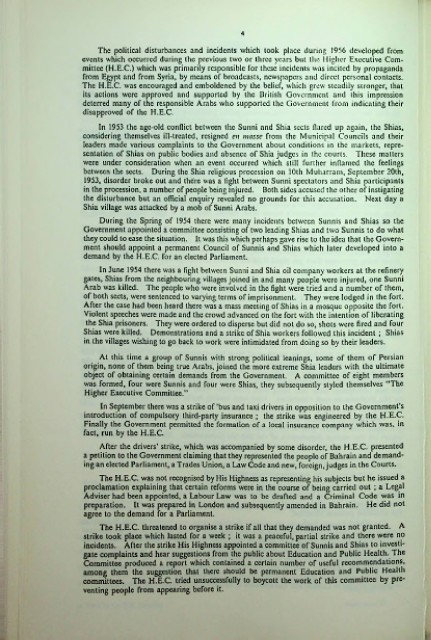Page 340 - Bahrain Gov annual reports(V)_Neat
P. 340
4
The political disturbances and incidents which took place during 1956 developed from
events which occurred during the previous two or three years but the Higher Executive Com
mittee (H.E.C.) which was primarily responsible for these incidents was incited by propaganda
from Egypt and from Syria, by means of broadcasts, newspapers and direct personal contacts.
The H.E.C. was encouraged and emboldened by the belief, which grew steadily stronger, that
its actions were approved and supported by the British Government and this impression
deterred many of the responsible Arabs who supported the Government from indicating their
disapproved of the H.E.C.
In 1953 the age-old conflict between the Sunni and Shia sects flared up again, the Shias,
considering themselves ill-treated, resigned en masse from the Municipal Councils and their
leaders made various complaints to the Government about conditions in the markets, repre
sentation of Shias on public bodies and absence of Shia judges in the courts. These matters
were under consideration when an event occurred which still further inflamed the feelings
between the seels. During the Shia religious procession on 10th Muharram, September 20th,
1953, disorder broke out and there was a light between Sunni spectators and Shia participants
in the procession, a number of people being injured. Both sides accused the other of instigating
the disturbance but an official enquiry revealed no grounds for this accusation. Next day a
Shia village was attacked by a mob of Sunni Arabs.
During the Spring of 1954 there were many incidents between Sunnis and Shias so the
Government appointed a committee consisting of two leading Shias and two Sunnis to do what
they could to ease the situation. It was this which perhaps gave rise to the idea that the Govern
ment should appoint a permanent Council of Sunnis and Shias which later developed into a
demand by the H.E.C. for an elected Parliament.
In June 1954 there was a fight between Sunni and Shia oil company workers at the refinery
gates, Shias from the neighbouring villages joined in and many people were injured, one Sunni
Arab was killed. The people who were involved in the fight were tried and a number of them,
of both sects, were sentenced to varying terms of imprisonment. They were lodged in the fort.
After the case had been heard there was a mass meeting of Shias in a mosque opposite the fort.
Violent speeches were made and the crowd advanced on the fort with the intention of liberating
the Shia prisoners. They were ordered to disperse but did not do so, shots were fired and four
Shias were killed. Demonstrations and a strike of Shia workers followed this incident ; Shias
in the villages wishing to go back to work were intimidated from doing so by their leaders.
At this time a group of Sunnis with strong political leanings, some of them of Persian
origin, none of them being true Arabs, joined the more extreme Shia leaders with the ultimate
object of obtaining certain demands from the Government. A committee of eight members
was formed, four were Sunnis and four were Shias, they subsequently styled themselves “The
Higher Executive Committee.”
In September there was a strike of ’bus and taxi drivers in opposition to the Government’s
introduction of compulsory third-party insurance ; the strike was engineered by the H.E.C.
Finally the Government permitted the formation of a local insurance company which was, in
fact, run by the H.E.C.
After the drivers’ strike, which was accompanied by some disorder, the H.E.C. presented
a petition to the Government claiming that they represented the people of Bahrain and demand
ing an elected Parliament, a Trades Union, a Law Code and new, foreign, judges in the Courts.
The H.E.C. was not recognised by His Highness as representing his subjects but he issued a
proclamation explaining that certain reforms were in the course of being carried out ; a Legal
Adviser had been appointed, a Labour Law was to be drafted and a Criminal Code was in
preparation. It was prepared in London and subsequently amended in Bahrain. He did not
agree to the demand for a Parliament.
The H.E.C. threatened to organise a strike if all that they demanded was not granted. A
strike took place which lasted for a week ; it was a peaceful, partial strike and there were no
incidents. After the strike His Highness appointed a committee of Sunnis and Shias to investi
gate complaints and hear suggestions from the public about Education and Public Health. The
Committee produced a report which contained a certain number of useful recommendations,
among them the suggestion that there should be permanent Education and Public Health
committees. The H.E.C. tried unsuccessfully to boycott the work of this committee by pre
venting people from appearing before it.

